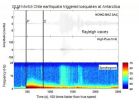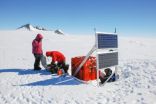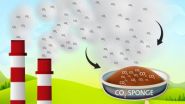(Press-News.org) VIDEO:
High-frequency icequakes are shown at station HOWD in Antarctica during the distant waves of the 2010 magnitude 8.8 Chile earthquake. The triggered icequakes are indicated by the narrow vertical bands...
Click here for more information.
Seismic events aren't rare occurrences on Antarctica, where sections of the frozen desert can experience hundreds of micro-earthquakes an hour due to ice deformation. Some scientists call them icequakes. But in March of 2010, the ice sheets in Antarctica vibrated a bit more than usual because of something more than 3,000 miles away: the 8.8-magnitude Chilean earthquake. A new Georgia Institute of Technology study published in Nature Geoscience is the first to indicate that Antarctica's frozen ground is sensitive to seismic waves from distant earthquakes.
To study the quake's impact on Antarctica, the Georgia Tech team looked at seismic data from 42 stations in the six hours before and after the 3:34 a.m. event. The researchers used the same technology that allowed them to "hear" the seismic response at large distances for the devastating 2011 magnitude 9 Japan earthquake as it rumbled through the earth. In other words, they simply removed the longer-period signals as the seismic waves spread from the distant epicenter to identify high-frequency signals from nearby sources. Nearly 30 percent (12 of the 42 stations) showed clear evidence of high-frequency seismic signals as the surface-wave arrived on Antarctica.
"We interpret these events as small icequakes, most of which were triggered during or immediately after the passing of long-period Rayleigh waves generated from the Chilean mainshock," said Zhigang Peng, an associate professor in the School of Earth and Atmospheric Sciences who led the study. "This is somewhat different from the micro-earthquakes and tremor caused by both Love and Rayleigh-type surface waves that traditionally occur in other tectonically active regions thousands of miles from large earthquakes.
VIDEO:
High-frequency icequakes are shown at station AGO (near the South Pole) in Antarctica during the distant waves of the 2010 magnitude 8.8 Chile earthquake. The triggered icequakes are indicated by...
Click here for more information.
Peng says the subtle difference is that micro-earthquakes respond to both shearing and volumetric deformation from distant events. The newly found icequakes respond only to volumetric deformation.
"Such differences may be subtle, but they tell us that the mechanism of these triggered icequakes and small earthquakes are different," Peng added. "One is more like cracking, while the other is like a shear slip event. It's similar to two hands passing each other."
Some of the icequakes were quick bursts and over in less than one second. Others were long duration, tremor-like signals up to 10 seconds. They occurred in various parts of the continent, including seismic stations along the coast and near the South Pole.
The researchers found the clearest indication of induced high-frequency signals at station HOWD near the northwest corner of the Ellsworth Mountains. Short bursts occurred when the P wave hit the station, then continued again when the Rayleigh wave arrived. The triggered icequakes had very similar high waveform patterns, which indicates repeated failure at a single location, possibly by the opening of cracks.
Peng says the source locations of the icequakes are difficult to determine because there isn't an extensive seismic network coverage in Antarctica.
"But at least some of the icequakes themselves create surface waves, so they are probably formed very close to the ice surface," he added. "While we cannot be certain, we suspect they simply reflect fracturing of ice in the near surface due to alternating volumetric compressions and expansions as the Rayleigh waves passed through Antarctica's frozen ice."
Antarctica was originally not on the research team's target list. While examining seismic stations in the Southern Hemisphere, Peng "accidently" found the triggered icequakes at a few openly available stations. He and former Georgia Tech postdoctoral student Jake Walter (now a research scientist at the Institute for Geophysics at UT Austin) then reached out to other seismologists (the paper's four co-authors) who were in charge of deploying more broadband seismometers in Antarctica.
INFORMATION:
This project is partially supported by a National Science Foundation CAREER grant (EAR-0956051). Any conclusions expressed are those of the principal investigator and may not necessarily represent the official views of the NSF.
2010 Chilean earthquake causes icequakes in Antarctica
Technology allows scientists to hear seismic waves as they arrived on frozen continent
2014-08-10
ELSE PRESS RELEASES FROM THIS DATE:
Target identified for rare inherited neurological disease in men
2014-08-10
Researchers at University of California, San Diego School of Medicine have identified the mechanism by which a rare, inherited neurodegenerative disease causes often crippling muscle weakness in men, in addition to reduced fertility.
The study, published August 10 in the journal Nature Neuroscience, shows that a gene mutation long recognized as a key to the development of Kennedy's disease impairs the body's ability to degrade, remove and recycle clumps of "trash" proteins that may otherwise build up on neurons, progressively impairing their ability to control muscle ...
The grass really is greener on TV and computer screens, thanks to quantum dots
2014-08-10
SAN FRANCISCO, Aug. 10, 2014 — High-tech specks called quantum dots could bring brighter, more vibrant color to mass market TVs, tablets, phones and other displays. Today, a scientist will describe a new technology called 3M quantum dot enhancement film (QDEF) that efficiently makes liquid crystal display (LCD) screens more richly colored.
His talk will be one of nearly 12,000 presentations at the 248th National Meeting & Exposition of the American Chemical Society (ACS), the world's largest scientific society, taking place here through Thursday.
"Green grass just pops ...
Pregnant women and fetuses exposed to antibacterial compounds face potential health risks
2014-08-10
SAN FRANCISCO, Aug. 10, 2014 — As the Food and Drug Administration (FDA) mulls over whether to rein in the use of common antibacterial compounds that are causing growing concern among environmental health experts, scientists are reporting today that many pregnant women and their fetuses are being exposed to these substances. They will present their work at the 248th National Meeting & Exposition of the American Chemical Society (ACS), the world's largest scientific society.
The meeting, which takes place here through Thursday, features nearly 12,000 presentations on a ...
Wine symposium explores everything you wanted to know about the mighty grape (video)
2014-08-10
San Francisco, Aug. 10, 2014 — Location. Location. Location. The popular real estate mantra also
turns out to be equally important for growing wine grapes in fields and storing bottles of the beverage at home or in restaurants, according to researchers.
Those are just two of the topics that will be covered in a symposium titled, "Advances in Wine Research," that will run today through Tuesday at the 248th National Meeting & Exposition of the American Chemical Society (ACS). The meeting features nearly 12,000 reports. A brand-new ACS video on the topics is available ...
Carbon dioxide 'sponge' could ease transition to cleaner energy
2014-08-10
SAN FRANCISCO, Aug. 10, 2014 — A sponge-like plastic that sops up the greenhouse gas carbon dioxide (CO2) might ease our transition away from polluting fossil fuels and toward new energy sources, such as hydrogen. The material — a relative of the plastics used in food containers — could play a role in President Obama's plan to cut CO2 emissions 30 percent by 2030, and could also be integrated into power plant smokestacks in the future.
The report on the material is one of nearly 12,000 presentations at the 248th National Meeting & Exposition of the American Chemical Society ...
On the frontiers of cyborg science
2014-08-10
SAN FRANCISCO, Aug. 10, 2014 — No longer just fantastical fodder for sci-fi buffs, cyborg technology is bringing us tangible progress toward real-life electronic skin, prosthetics and ultraflexible circuits. Now taking this human-machine concept to an unprecedented level, pioneering scientists are working on the seamless marriage between electronics and brain signaling with the potential to transform our understanding of how the brain works — and how to treat its most devastating diseases.
Their presentation is taking place at the 248th National Meeting & Exposition of ...
Like cling wrap, new biomaterial can coat tricky burn wounds and block out infection
2014-08-10
SAN FRANCISCO, Aug. 10, 2014 — Wrapping wound dressings around fingers and toes can be tricky, but for burn victims, guarding them against infection is critical. Today, scientists are reporting the development of novel, ultrathin coatings called nanosheets that can cling to the body's most difficult-to-protect contours and keep bacteria at bay.
The researchers are speaking about their materials, which they've tested on mice, at the 248th National Meeting & Exposition of the American Chemical Society (ACS), the world's largest scientific society.
The meeting features ...
Women who 'lean in' often soon leave engineering careers, study finds
2014-08-09
WASHINGTON –- Nearly 40 percent of women who earn engineering degrees quit the profession or never enter the field, and for those who leave, poor workplace climates and mistreatment by managers and co-workers are common reasons, according to research presented at the American Psychological Association's 122nd Annual Convention.
While women accounted for more than 20 percent of engineering school graduates over the past two decades, only 11 percent of practicing engineers are women, and only 9 percent of electronic and environmental engineers are, said Nadya Fouad, PhD, ...
Happier consumers can lead to healthier environment, research reveals
2014-08-09
WASHINGTON -- The pursuit of true happiness can lead people to lifestyles that will not only be satisfying but will be better for the environment, according to an overview of psychological research presented at the American Psychological Association's 122nd Annual Convention.
"For decades, consumerism has been on a collision course with the environment, with consumer appetites draining the planet of natural resources and accelerating global warming. One view is that we need to change consumption in order to save the planet," said Miriam Tatzel, PhD, of Empire State College. ...
Trauma before enlistment linked to high suicide rates among military personnel, veterans
2014-08-09
WASHINGTON -- High rates of suicide among military service members and veterans may be related to traumatic experiences they had before enlisting, making them more vulnerable to suicidal behavior when coping with combat and multiple deployments, according to the findings of several recent studies presented at the American Psychological Association's 122nd Annual Convention.
Experiencing child abuse, being sexually victimized by someone not in the service and exhibiting suicidal behavior before enlisting are significant risk factors for service members and veterans who ...
LAST 30 PRESS RELEASES:
Chonnam National University researchers propose innovative voltage-loop control for power factor correction
Accelerating next-generation drug discovery with click-based construction of PROTACs
Detecting the hidden magnetism of altermagnets
$7M gift supports health research, engineering and athletics at UT San Antonio
NU-9 halts Alzheimer’s disease in animal model before symptoms begin
Hospitals acquired by real estate investment trusts associated with greater risk of bankruptcy, closure
City of Hope scientists study rare disorder to uncover mechanism and hormone regulation underlying fatty liver disease and sweet aversion
Your genes may influence gut microbiome of others, rat study shows
‘Personality test’ shows how AI chatbots mimic human traits – and how they can be manipulated
Global food systems driving twin crises of obesity and global heating
Osaka Medical and Pharmaceutical University researchers capture real-time molecular movies of enzyme catalysis
Could your genes influence the gut microbiome of others?
Clues to Alzheimer’s disease may be hiding in our ‘junk’ DNA
Study reveals that the body uses different sensors to detect cold in the skin and in internal organs
iPS cells from dish to freezer and back
Deep neural networks enable accurate pricing of American options under stochastic volatility
Collective risk resonance in Chinese stock sectors uncovered through higher-order network analysis
Does CPU impact systemic risk contributions of Chinese sectors? Evidence from mixed frequency methods with asymmetric tail long memory
General intelligence framework to predict virus adaptation based on a genome language model
Antibiotic resistance is ancient, ecological, and deeply connected to human activity, new review shows
Vapes, pouches, heated tobacco, shisha, cigarettes: nicotine in all forms is toxic to the heart and blood vessels
From powder to planet: University of Modena engineers forge a low-carbon future for advanced metal manufacturing
Super strain-resistant superconductors
Pre-school health programme does not improve children’s diet or physical activity, prompting call for policy changes, study finds
Autumn clock change linked to reduction in certain health conditions
AI images of doctors can exaggerate and reinforce existing stereotypes
Where medicine meets melody – how lullabies help babies and parents in intensive care
We may never be able to tell if AI becomes conscious, argues philosopher
AI video translation shows promise but humans still hold the edge
Deep ocean earthquakes drive Southern Ocean’s massive phytoplankton blooms, study finds
[Press-News.org] 2010 Chilean earthquake causes icequakes in AntarcticaTechnology allows scientists to hear seismic waves as they arrived on frozen continent






